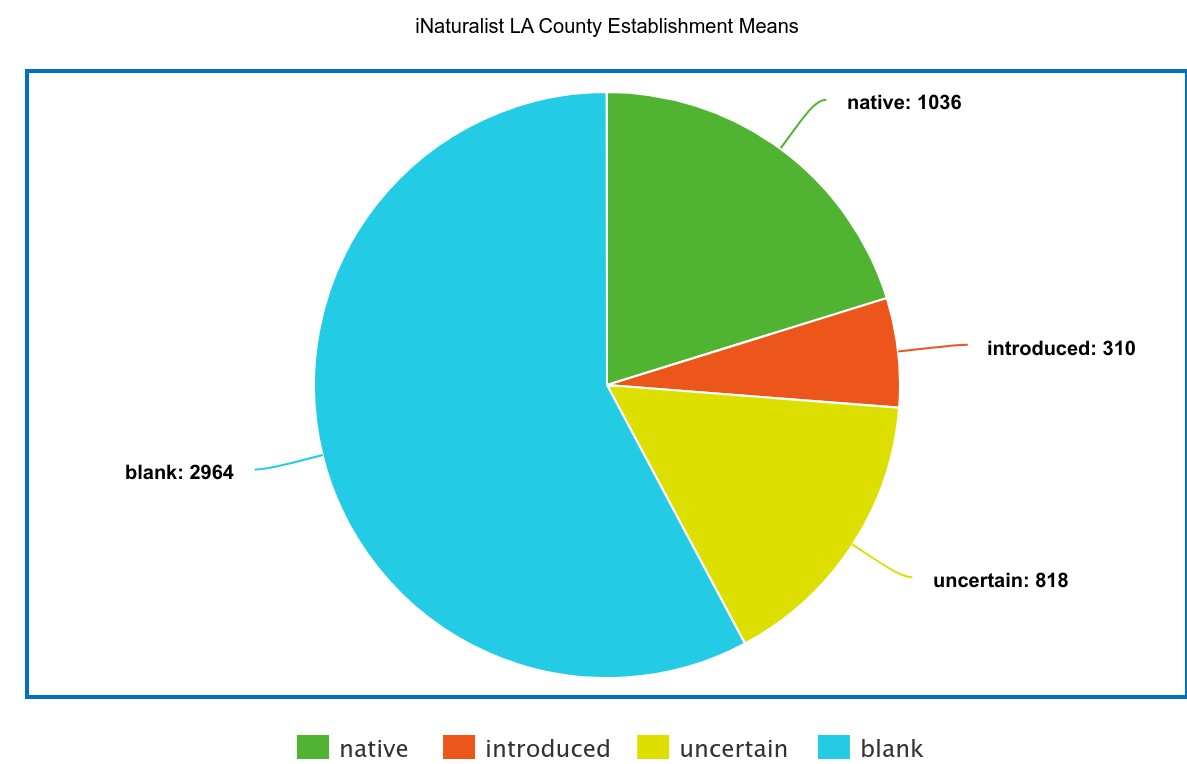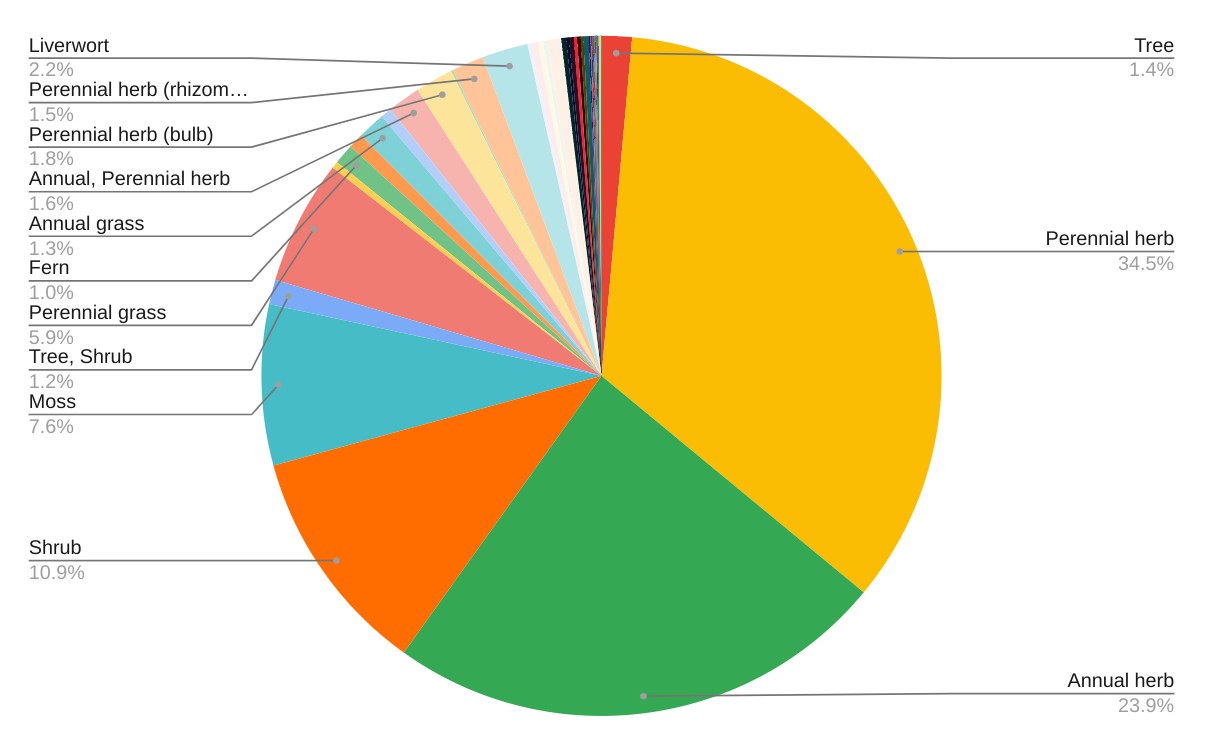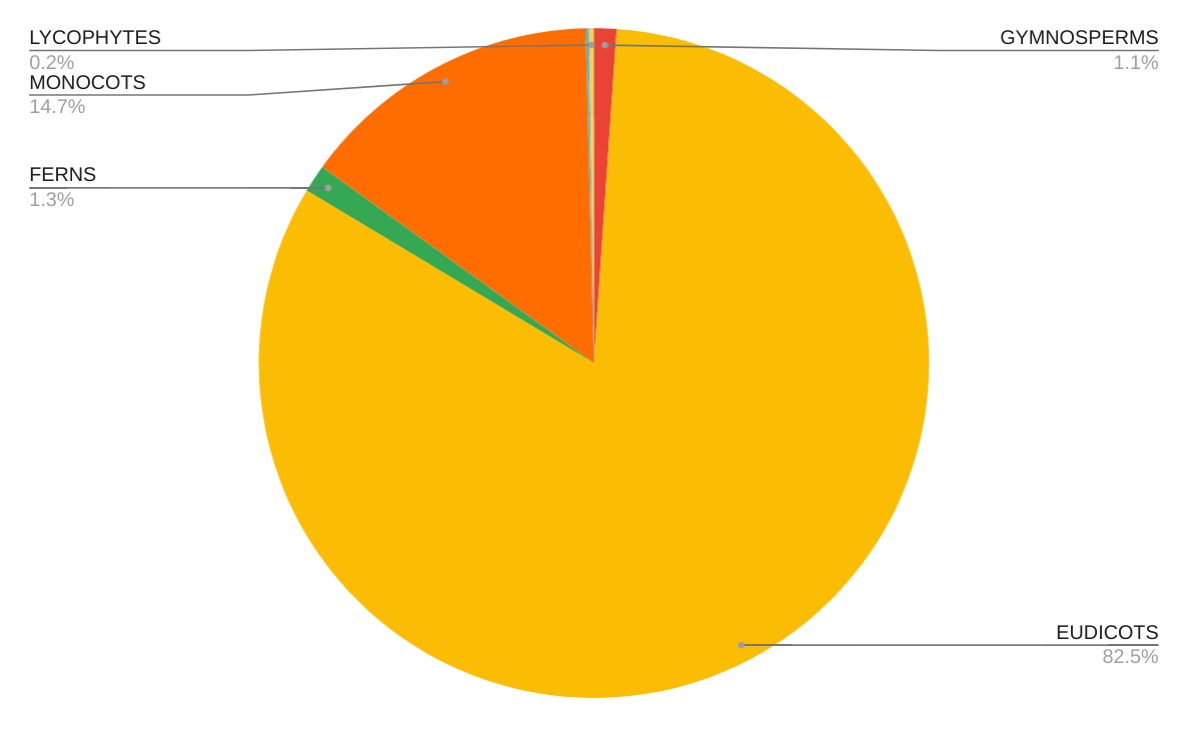
*GBIF (mostly iNaturalist data) LA County Establishment Means (Counted By Unique Taxa)*
For LA County, iNaturalist only has 1036 plant taxa marked as native, whereas Calflora for example has 3058 taxa. Even though this is only LA County, we can expect the statewide iNaturalist data to be similarly missing.So in summary iNaturalist's taxonomy system itself is not suitable for determining if a plant is native (At least in California), so we need to use another authority.
The nice thing about iNaturalist's taxonomy system is they have a machine readable TaxonID for each taxon, and they also track name changes and synonyms for each taxon. This makes it great to work with as a software developer.
Even though iNaturalist doesn't have the ability to filter by native plants, a workaround is to create a Project, add your taxa to the project, and then use the project as a filter in your searches. You can read more about that [here](https://www.inaturalist.org/journal/maxo/79403-california-native-invasive-endangered-and-special-species-on-inaturalist).
When talking about vascular plants on iNaturalist, they are based on [Kew Garden's POWO](https://powo.science.kew.org/) (Plants Of The World). This means if POWO doesn't recognize something as a species, then neither should iNaturalist.
### Calflora
The next authority is Calflora, who recognizes (as of this blog post) [8195](https://www.calflora.org/entry/advanced.html#active=1&nstatus=2&cat=ov&cols=0,10,1,2,4&srch=t) native vascular plant species in California. 8195 makes it the largest list of California Native Plant taxa.

*Calflora plant categories*
### Jepson
Jepson also publishes [a list of plant taxa Native to California](https://ucjeps.berkeley.edu/eflora/tools/). Their list weighs in at 7396 taxa.

*Jepson major clades*
### Burge et al. 2016
Finally, in the 2016 paper ["Plant Diversity and Endemism in the California Floristic Province"](https://www.researchgate.net/publication/302633705_PLANT_DIVERSITY_AND_ENDEMISM_IN_THE_CALIFORNIA_FLORISTIC_PROVINCE), Burge and the other authors made the "first attempt at a comprehensive list of the native and endemic plants of the CFP", but that "it is by no means a final or perfect list". [Their list](https://datadryad.org/stash/dataset/doi:10.5061/dryad.d4g4n) comes in at 6514 vascular plant taxa (although the paper mentions 6,143 vascular minimum rank taxa, so I'm not sure why there's a discrepancy).
### Comparing to iNaturalist
So, with Burge et al, Calflora, and Jepson all claiming to have different numbers of native plant species, I decided to compare the 3 lists to iNaturalist to see which species are present or not present in the iNaturalist/POWO taxonomy system.
First, I downloaded the 3 above databases into CSV files. The Burge et al. data was already available as an .XLS, but unfortunately I had to scrape the HTML of Jepson and Calflora, who do not offer machine readable downloads of their taxonomy.
I also downloaded the `inaturalist-taxonomy.dwca.zip` file from iNaturalist which includes their entire current taxonomy database, not including all the synonyms. Then, using [this code that I wrote](https://github.com/max-mapper/inaturalist-taxonomy-import), I looked up all of the ~25,000 species names on the 3 lists and tried to find an exact match on iNaturalist.
My results, including the above mentioned 3 databases, are available in [this google spreadsheet](https://docs.google.com/spreadsheets/d/1-c45X-BvIVbgSPacDXsyR9OIywnIWtghAa1_K3lS6v8/edit?gid=1121254792#gid=1121254792).
I also included the [California Rare Plant Rankings (CRPR)](https://rareplants.cnps.org/) database, which I also had to scrape due to lack of machine readable downloads.
The last tab in the spreadsheet, `MissingFromiNat`, has a list of all species that iNaturalist does not recognize. I'll include them here for sake of completeness.
### Species missing from iNaturalist
For a breakdown by data source see the above linked spreadsheet.
```
Acmispon tomentosus var. glabriusculus
Amsinckiopsis kingii var. harknessii
Antirrhinum pusillum
Arctostaphylos campbelliae
Aristida schiedeana var. orcuttiana
Atriplex gypsophila
Brickellia californica var. jepsonii
Brickellia subsessilis
Bromus sitchensis var. maritimus
Bromus sitchensis var. polyanthus
Carex norvegica ssp. inferalpina
Castilleja applegatei ssp. martinii
Cheilanthes fibrillosa
Cheilanthes parishii
Chenopodium album var. stevensii
Chylismia cardiophylla subsp. cedrosensis
Cimicifuga elata var. alpestris
Cleomella oxystyloides
Collinsia sparsiflora var. bruceae
Descurainia pinnata ssp. intermedia
Downingia ornatissima var. mirabilis
Drepanocladus polycarpos
Eleocharis acicularis var. gracilescens
Eleocharis acicularis var. occidentalis
Eleocharis engelmannii var. detonsa
Elymus elymoides ssp. hordeoides
Elymus elymoides var. hordeoides
Engellaria obtusa
Eriastrum brandegeeae
Eriastrum sapphirinum ssp. ambiguum
Erigeron foliosus var. mendocinus
Eriogonum blissianum
Eriogonum elongatum var. vollmeri
Eriogonum inerme var. hispidulum
Eriogonum microthecum var. corymbosoides
Eriogonum microthecum var. johnstonii
Eriogonum microthecum var. lacus-ursi
Eriogonum wrightii var. taxifolium
Eriophyllum lanatum var. aphanactis
Eucephalus glabratus
Ferocactus fordii var. grandiflorus
Gentiana affinis var. parvidentata
Gilia achilleifolia subsp. abrotanifolia
Githopsis pulchella var. glabra
Harfordia macroptera var. fruticosa
Harfordia macroptera var. galioides
Heterotheca brandegeei
Heterotheca oregona var. rudis
Hierochloe hirta ssp. arctica
Horkelia californica var. frondosa
Ivesia argyrocoma var. moranii
Laphamia intricata
Laphamia inyoensis
Laphamia megalocephala
Laphamia megalocephala var. megalocephala
Laphamia megalocephala var. oligophylla
Leptosiphon ciliatus ssp. neglectus
Lessingia virgata var. glomerata
Lipocarpha aristulata
Lupinus holmgrenianus
Lupinus littoralis var. variicolor
Lupinus odoratus var. pilosellus
Malacothrix insularis
Mammillaria goodridgii var. rectispina
Mesoptychia polymorpha
Mirabilis laevis var. cedrosensis
Myosurus apetalus var. borealis
Nama densa var. parviflora
Noccaea fendleri subsp. siskiyouense
Orobanche ludoviciana var. arenosa
Panicum alatum var. longiflorum
Pellaea glaciogena
Phacelia malvifolia var. loasifolia
Phacelia umbrosa
Pityopus californica
Planodes virginica
Polycarpon tetraphyllum ssp. depressum
Potentilla millefolia var. klamathensis
Potentilla norrelmukana
Prunus subcordata var. kelloggii
Rhododendron occidentale var. paludosum
Sedum obtusatum subsp. boreale
Sedum obtusatum subsp. retusum
Senecio clevelandii var. heterophyllus
Silene occidentalis ssp. longistipitata
Spergularia macrotheca var. talinum
Streptanthus glandulosus ssp. arkii
Streptanthus glandulosus ssp. raichei
Streptanthus morrisonii ssp. hirtiflorus
Streptanthus morrisonii ssp. kruckebergii
Streptanthus tortuosus var. foliosus
Streptanthus tortuosus var. oblongus
Streptanthus tortuosus var. optatus
Streptanthus tortuosus var. pallidus
Thalictrum fendleri var. quadrinervatum
Thysanocarpus curvipes ssp. longistylus
Thysanocarpus curvipes subsp. amplectans
Thysanocarpus curvipes subsp. longistylus
Torreyostellaria jamesiana
Tragia nepetifolia var. dissecta
Trifolium appendiculatum
Xylonagra arborea subsp. wigginsii
```
This work by Max Yasuda is licensed under CC BY-NC 4.0